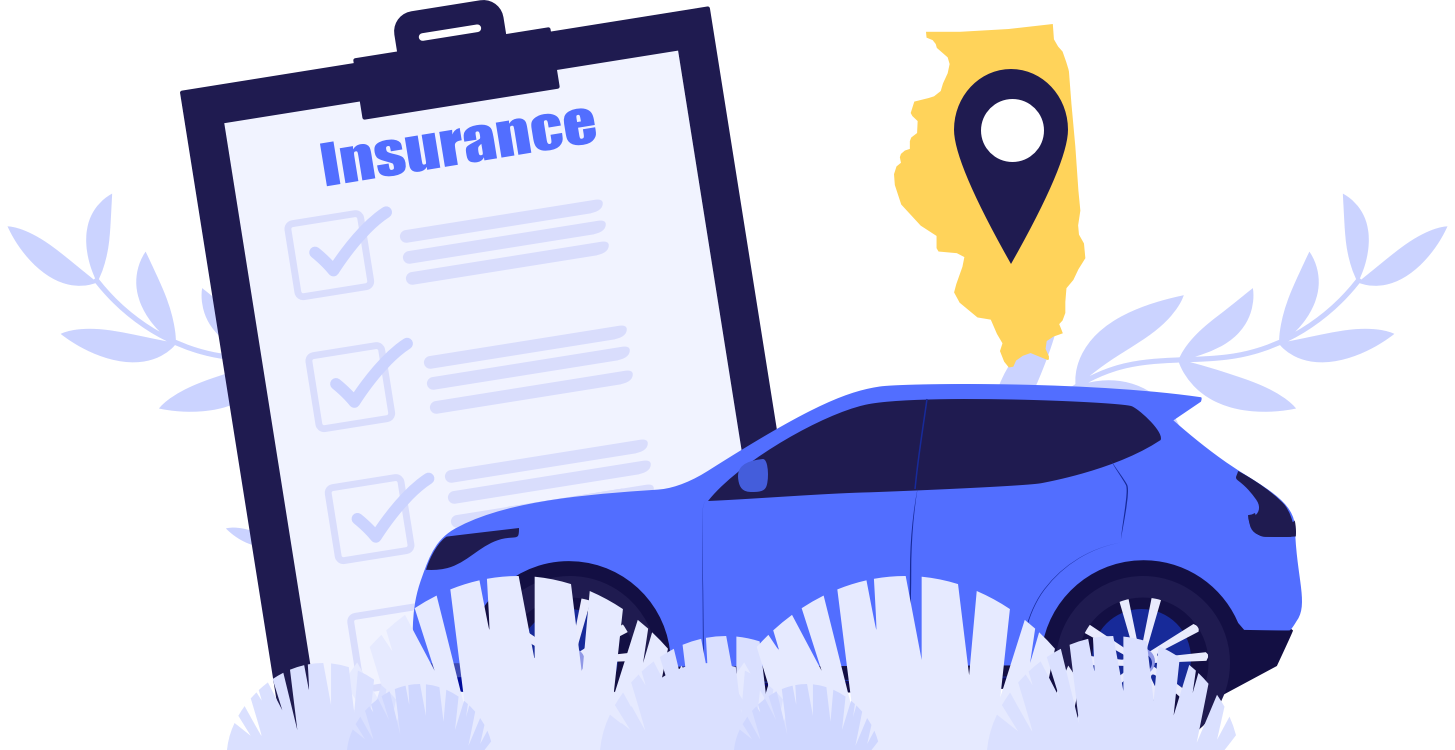Cheapest Car Insurance in Illinois (June 2024)


Updated: June 14, 2024
Advertising & Editorial Disclosure
Mercury is the cheapest car insurance company in Illinois overall, having the lowest minimum coverage rates. For certain types of drivers, American Family and Progressive might have lower rates.
If you’re looking to balance cost with service quality, MoneyGeek identified the best car insurance companies in Illinois.
Table of Contents



Why Trust MoneyGeek? Illinois car insurance quotes used in this study were collected from the Illinois Department of Insurance and Quadrant Information Services.
These rates reflect the cheapest car insurance quotes in Illinois as of June 2024.
Cheapest Minimum Liability Car Insurance in Illinois (June 2024)
In Illinois, the cheapest auto insurance companies for a minimum coverage policy are:
- Mercury: $274 per year
- Country Financial: $338 per year
The most expensive minimum coverage car insurance in Illinois is offered by Grange Insurance at roughly $707 per year, based on the companies MoneyGeek assessed. Car insurance that meets Illinois’ minimum car insurance requirements covers bodily injury liability, property damage liability and uninsured or underinsured motorist insurance.
| Mercury | Annual Premium$274 | Monthly Premium$23 |
| Country Financial | Annual Premium$338 | Monthly Premium$28 |
| Auto-Owners Insurance Co | Annual Premium$379 | Monthly Premium$32 |
| GEICO | Annual Premium$383 | Monthly Premium$32 |
| Westfield | Annual Premium$398 | Monthly Premium$33 |
| American Family | Annual Premium$414 | Monthly Premium$34 |
| Travelers | Annual Premium$435 | Monthly Premium$36 |
| Erie | Annual Premium$460 | Monthly Premium$38 |
Car insurance with minimum coverage only pays for the cost of damages or injuries you inflict on others in an accident. If you want protection that extends to your own vehicle, consider buying a full coverage policy that includes comprehensive and collision insurance.

Find the Best Car Insurance in Illinois for You
Your car insurance rates depend on your preferences and insurance requirements. The table above lists the lowest premiums for minimum coverage car insurance in Illinois.
Determine how much car insurance you need.

We examined providers based on cost and service quality to find the best car insurance in Illinois.
Our study analyzed the average cost of Illinois car insurance for different driver profiles to show how certain factors affect rates.
Cheapest Full Coverage Car Insurance in Illinois (June 2024)
Our study determined that the cheapest full coverage car insurance companies in Illinois are:
- American Family: $723 per year
- Travelers: $879 per year
Based on MoneyGeek's assessment, the most expensive full coverage policy in Illinois costs roughly $2,025 per year from Hanover.
Adding comprehensive and collision insurance to your auto policy will make your premium more expensive. In Illinois, for instance, opting for full coverage car insurance costs an average of $309 more than minimum coverage with the cheapest providers. A full coverage policy will financially protect you and your vehicle against damages caused by on-road accidents (hitting another car or object) and off-road incidents (vandalism, theft, fire and weather hazards).
| American Family | Annual Premium$723 | Monthly Premium$60 |
| Travelers | Annual Premium$879 | Monthly Premium$73 |
| Country Financial | Annual Premium$887 | Monthly Premium$74 |
| Auto-Owners Insurance Co | Annual Premium$898 | Monthly Premium$75 |
| GEICO | Annual Premium$925 | Monthly Premium$77 |
| Westfield | Annual Premium$1,115 | Monthly Premium$93 |
| Erie | Annual Premium$1,141 | Monthly Premium$95 |
| Progressive | Annual Premium$1,245 | Monthly Premium$104 |
How much car insurance you need will significantly influence your rates. Our study’s sample full coverage policy has the following liability limits:
- $100,000 bodily injury per person
- $300,000 bodily injury per accident
- $100,000 property damage per accident
To reduce your premium, you can lower your liability limits, remove comprehensive and collision insurance or raise your deductible. By doing so, however, you risk having insufficient coverage in the event of an accident.
How to Compare Cheap Illinois Car Insurance Quotes Online
You can get quotes online from different car insurance providers, but you must submit personal information for each, which can take up to 15 minutes. To compare rates across multiple companies, you must spend more time repeating this process.
Our car insurance calculator can help you get a quick estimate without providing specific personal details. Enter your age, gender and driving record below to find the lowest rates for your profile.
Car Insurance Calculator
MoneyGeeks's car insurance calculator will give you a customized estimate of your auto insurance cost. It's free to use, requires no personal information and we won't send you any spam.
Rates updated:
Jun 15, 2024
Although MoneyGeek partners with some of the companies we recommend, our content is written and reviewed by an independent team of writers, editors and licensed agents. Learn more about our editorial policies and expert editorial team.
Cheapest Car Insurance in Illinois by Age (June 2024)
Car insurance rates in Illinois are heavily influenced by age. On average, for teens, Progressive offers the most affordable prices, while American Family offers the most affordable prices for both young adults and seniors.
Cheapest Car Insurance in Illinois for Teens and Their Families (June 2024)
The two companies providing the cheapest car insurance for teens in Illinois are:
- Progressive: $2,195 per year for teen boys and $2,026 per year for teen girls
- Auto-Owners: $2,236 per year for teen boys; Travelers: $2,047 per year for teen girls
GEICO offers the most expensive car insurance in Illinois for teen boys and girls, at an average of $3,217 per year and $2,932 per year, respectively. These rates are for a 16-year-old on a parent’s policy.
Among the teens, 19-year-olds pay the cheapest car insurance premiums because teens' rates decrease as they age. Auto-Owners ($1,609 per year) has the lowest rates for 19-year-old males in Illinois compared to its competitors.
Teens tend to pay less if they are added to a parent’s policy than if they buy separate insurance. In most cases, it is illegal for a teen under 18 to purchase auto insurance without a parent or guardian to co-sign. In Illinois, 16-year-olds save around $2,566 per year if they’re on a parent’s policy instead of buying their own policy.
| Progressive | Family Plan Annual Premium$2,026 | Individual Plan Annual Premium$4,569 |
| Travelers | Family Plan Annual Premium$2,047 | Individual Plan Annual Premium$6,370 |
| State Farm | Family Plan Annual Premium$2,059 | Individual Plan Annual Premium$2,833 |
| Auto-Owners Insurance Co | Family Plan Annual Premium$2,186 | Individual Plan Annual Premium$1,979 |
| Allstate | Family Plan Annual Premium$2,499 | Individual Plan Annual Premium$4,872 |
| GEICO | Family Plan Annual Premium$2,932 | Individual Plan Annual Premium$6,524 |
Families in Illinois who want to reduce their insurance premiums may qualify for student discounts. Many companies, including Auto-Owners, Allstate, Progressive and State Farm, offer discounts for both students away from home and those with good academic performance.
Cheapest Car Insurance in Illinois for Young Adults (June 2024)
We discovered that the companies providing the cheapest car insurance in Illinois for drivers in their 20s are:
- American Family: $775 per year
- Travelers: $1,032 per year
At an average of $2,628 per year, Hanover charges the most for young adult drivers. In addition, 25-year-old drivers in Illinois pay about $297 more for an American Family policy than a 40-year-old due to younger adults' higher risk of at-fault accidents.
| American Family | Annual Premium$775 | Monthly Premium$65 |
| Travelers | Annual Premium$1,032 | Monthly Premium$86 |
| Country Financial | Annual Premium$1,136 | Monthly Premium$95 |
| GEICO | Annual Premium$1,189 | Monthly Premium$99 |
| Auto-Owners Insurance Co | Annual Premium$1,190 | Monthly Premium$99 |
| Westfield | Annual Premium$1,421 | Monthly Premium$118 |
| Erie | Annual Premium$1,453 | Monthly Premium$121 |
| AAA | Annual Premium$1,460 | Monthly Premium$122 |
Cheapest Car Insurance in Illinois for Seniors (June 2024)
The following companies offer the most affordable car insurance for seniors in Illinois:
- American Family: $703 per year
- Country Financial: $820 per year
Hanover provides the highest rate for senior drivers, at roughly $1,871 annually. In Illinois, drivers in their 60s pay about $59 less for insurance coverage from American Family than those in their 40s. However, rates typically increase when drivers reach their 70s and 80s due to increased risk factors.
| American Family | Annual Premium$703 | Monthly Premium$59 |
| Country Financial | Annual Premium$820 | Monthly Premium$68 |
| Auto-Owners Insurance Co | Annual Premium$864 | Monthly Premium$72 |
| Travelers | Annual Premium$868 | Monthly Premium$72 |
| GEICO | Annual Premium$892 | Monthly Premium$74 |
| Westfield | Annual Premium$1,074 | Monthly Premium$90 |
| AAA | Annual Premium$1,077 | Monthly Premium$90 |
| Erie | Annual Premium$1,140 | Monthly Premium$95 |
Since various factors besides age are used to calculate rates, comparing multiple providers is the best way to find the cheapest car insurance for older drivers.
Cheapest Car Insurance for Higher Risk Drivers (June 2024)
Our study found that American Family is the cheapest insurance provider for drivers in Illinois with at-fault accidents, DUIs, tickets, and sports cars. Country Financial is the most affordable provider for people with poor credit.
Take state-approved driving courses to improve your profile and gradually get more affordable insurance options. But a DUI stays on your driving record for life in Illinois and can significantly impact the availability and cost of your car :insurance.
Cheapest after a ticket: American Family ($870 per year)
Cheapest after an accident: American Family ($850 per year)
Cheapest after a DUI: American Family ($870 per year)
Cheapest for poor credit: Country Financial ($1,290 per year)
Cheapest for sports cars: American Family ($679 per year)
Cheapest Car Insurance in Illinois After a Ticket
For Illinois drivers with a speeding ticket, the cheapest car insurance companies are:
- American Family: $870 per year
- Auto-Owners: $995 per year
Grange Insurance offers the most expensive coverage for drivers with tickets, at approximately $2,299 per year. In Illinois, getting a speeding ticket can increase your car insurance premium by $290, generating an annual premium surcharge for at least three years.
| American Family | Annual Premium$870 | Monthly Premium$72 |
| Auto-Owners Insurance Co | Annual Premium$995 | Monthly Premium$83 |
| Country Financial | Annual Premium$1,150 | Monthly Premium$96 |
| GEICO | Annual Premium$1,216 | Monthly Premium$101 |
| Travelers | Annual Premium$1,221 | Monthly Premium$102 |
| Erie | Annual Premium$1,244 | Monthly Premium$104 |
| Westfield | Annual Premium$1,326 | Monthly Premium$110 |
| AAA | Annual Premium$1,462 | Monthly Premium$122 |
Cheapest Car Insurance in Illinois After an Accident
These companies offer the most affordable policies for drivers in Illinois with an accident on their record:
- American Family: $850 per year
- Auto-Owners: $1,142 per year
The most expensive is Hanover, with their premium at $3,119. On average, middle-aged drivers in Illinois pay $558 more for a full coverage insurance policy if they have an accident on their record.
| American Family | Annual Premium$850 | Monthly Premium$71 |
| Auto-Owners Insurance Co | Annual Premium$1,142 | Monthly Premium$95 |
| Travelers | Annual Premium$1,269 | Monthly Premium$106 |
| Country Financial | Annual Premium$1,283 | Monthly Premium$107 |
| GEICO | Annual Premium$1,445 | Monthly Premium$120 |
| Erie | Annual Premium$1,542 | Monthly Premium$129 |
| Westfield | Annual Premium$1,573 | Monthly Premium$131 |
| AAA | Annual Premium$1,586 | Monthly Premium$132 |
Cheapest Car Insurance in Illinois After a DUI
The least expensive car insurance companies in Illinois for drivers with a DUI are:
- American Family: $870 per year
- Country Financial: $1,333 per year
Hanover offers the most expensive rate, at roughly $3,340 per year. Illinois drivers with a DUI on their record tend to pay about $723 more for car insurance than those with a clean record. And at the very minimum, they experience an annual premium surcharge for at least three years.
| American Family | Annual Premium$870 | Monthly Premium$72 |
| Country Financial | Annual Premium$1,333 | Monthly Premium$111 |
| Progressive | Annual Premium$1,408 | Monthly Premium$117 |
| Travelers | Annual Premium$1,410 | Monthly Premium$117 |
| State Farm | Annual Premium$1,507 | Monthly Premium$126 |
| Auto-Owners Insurance Co | Annual Premium$1,700 | Monthly Premium$142 |
| Mercury | Annual Premium$1,792 | Monthly Premium$149 |
| Erie | Annual Premium$1,838 | Monthly Premium$153 |
Cheapest Car Insurance in Illinois for Drivers With Poor Credit (June 2024)
In Illinois, the most affordable car insurance providers for drivers with poor credit are:
- Country Financial: $1,290 per year
- American Family: $1,313 per year
At $3,013 per year, State Farm is the most expensive insurer for drivers with poor credit. Insurance companies in Illinois consider credit history when calculating rates. Drivers with credit scores below 580 often pay about $861 more for coverage than those above 750.
| Country Financial | Annual Premium$1,290 | Monthly Premium$107 |
| American Family | Annual Premium$1,313 | Monthly Premium$109 |
| Travelers | Annual Premium$1,344 | Monthly Premium$112 |
| AAA | Annual Premium$1,835 | Monthly Premium$153 |
| Grange Insurance | Annual Premium$1,952 | Monthly Premium$163 |
| Mercury | Annual Premium$1,974 | Monthly Premium$165 |
| Westfield | Annual Premium$2,004 | Monthly Premium$167 |
| GEICO | Annual Premium$2,050 | Monthly Premium$171 |
Auto insurance companies found that those with poor credit are more likely to file claims, so they charge higher premiums to offset the costs of covering these drivers. Like many other states, Illinois does not ban insurers from considering credit-based insurance scores when calculating rates.
While improving your credit score gradually, you may seek companies that offer safe-driver or other discounts to help lower your insurance rate.
Cheapest Car Insurance in Illinois for Sports Cars (June 2024)
The following companies provide the least expensive car insurance for drivers in Illinois with a sports car:
- American Family: $679 per year
- Travelers: $844 per year
The most expensive provider is Progressive, with an average annual premium of $2,234. Because sports cars have higher repair and replacement costs, Illinois drivers with a sports car tend to pay $127 more for car insurance than those with a standard Toyota Camry LE.
| American Family | Annual Premium$679 | Monthly Premium$57 |
| Travelers | Annual Premium$844 | Monthly Premium$70 |
| Auto-Owners Insurance Co | Annual Premium$901 | Monthly Premium$75 |
| GEICO | Annual Premium$1,228 | Monthly Premium$102 |
| State Farm | Annual Premium$1,652 | Monthly Premium$138 |
| Allstate | Annual Premium$1,709 | Monthly Premium$142 |
| Progressive | Annual Premium$2,234 | Monthly Premium$186 |
Although we used the Ford Mustang in our example, remember that costs can vary greatly based on your car model. Luxury, electric and sports cars are much more expensive than standard model types. Insurance for these types of cars varies by state.
Cheapest Car Insurance in Illinois for Military Drivers (June 2024)
At an average of $723 per year, American Family is the cheapest car insurance provider for active military members and veterans in Illinois.
USAA also offers policies for military families at roughly $1,157 annually. This insurer is available in all states and tailors its service to those with a military background. However, there are many cheaper options for military personnel in Illinois.
You might also consider GEICO. It has multiple discounts available to military-affiliated drivers that can lower the cost of auto insurance.

- $723 annual premium
- Cheapest rank: first out of 15 auto insurers
Despite not offering a military discount, American Family remains the most affordable auto insurance provider in Illinois, offering competitive rates and additional discounts for other categories of customers.
Cheapest Car Insurance in Illinois by City
Various factors significantly affect the cost of car insurance in Illinois, including the city where you live. Living in a neighborhood with higher rates of accidents, thefts, or vandalism makes you more likely to file claims, so your premiums may be more expensive.
According to our study, the cheapest city in Illinois for car insurance is Peoria, where a full coverage policy from GEICO has an average annual rate of $745. Auto insurance is most expensive in Chicago, where a full coverage policy costs roughly $1,064 annually with American Family.
Check our table of Illinois cities to see how the average cost of car insurance changes depending on the location.
| Aurora | Cheapest CompanyAmerican Family | Annual Premium$800 |
| Chicago | Cheapest CompanyAmerican Family | Annual Premium$1,064 |
| Elgin | Cheapest CompanyAmerican Family | Annual Premium$832 |
| Joliet | Cheapest CompanyCountry Financial | Annual Premium$848 |
| Naperville | Cheapest CompanyAuto-Owners Insurance Co | Annual Premium$805 |
| Peoria | Cheapest CompanyGEICO | Annual Premium$745 |
| Rockford | Cheapest CompanyCountry Financial | Annual Premium$772 |
| Springfield | Cheapest CompanyCountry Financial | Annual Premium$778 |
Car Insurance in Illinois: What You Need to Know
In Illinois, drivers are required to carry a policy that includes uninsured/underinsured motorist coverage along with bodily injury liability (BIL) and property damage liability (PDL). They also have the option to self-insure if they own at least 25 cars.
Illinois Car Insurance Requirements
Illinois drivers are required to carry insurance that meets the minimum requirements for bodily injury liability, property damage liability and uninsured/underinsured motorist coverage. A minimum coverage policy is the cheapest insurance you can purchase, but it might offer inadequate coverage in case of an accident.
Additionally, SR-22 insurance is needed for drivers with serious traffic violations like reckless driving, driving without insurance, driving under the influence or driving with a suspended license, which typically leads to much higher rates than average drivers. SR-22 is a certificate filed by the insurer to prove the driver has the required insurance coverage in Illinois.
Bodily Injury Liability
In Illinois, you must have $25,000 in bodily injury liability for each person and $50,000 for each accident. If you get into an accident and cause injuries to someone else, you will be responsible for the other party’s medical costs that exceed these limits.
Property Damage Liability
Illinois drivers are required to have at least $20,000 in property damage liability. It will cover repairs up to $20,000 if you damage someone else’s property in an accident. If the cost of repairs is above this limit, you will have to pay out of pocket for the rest.
Uninsured/Underinsured Motorist Coverage
Illinois requires drivers to carry $25,000 in uninsured/underinsured motorist bodily injury liability for each person and $50,000 for each accident. If you get into an accident with an uninsured or underinsured driver, you must shoulder any costs exceeding these limits.
To ensure adequate financial protection in case of an at-fault accident, consider raising your liability limits to $100,000 in bodily injury for each person, $300,000 in bodily injury for each accident and $100,000 in property damage. If you finance or lease your car, you will likely be required to add comprehensive and collision insurance to your policy.
Comprehensive insurance covers the damage to your vehicle caused by vandalism, fires, natural disasters and weather-related incidents. Collision insurance pays for the damages to your car after hitting another vehicle or a stationary object.
Comprehensive and collision coverage is also recommended for drivers not financing or leasing a vehicle to have more excellent financial protection.
Car Insurance Alternatives in Illinois
Unless you have more than 25 vehicles registered under your name, there’s no alternative to car insurance in Illinois. If you own more than 25 cars, you may qualify for self-insurance. It means you will assume all financial responsibilities in case of a vehicular accident, including the cost of repairs and medical treatments.
To obtain a self-insurance certificate from the Illinois Department of Insurance director, you must be financially capable of paying for claims as a minimum coverage policy would.
The director, however, may cancel your certificate of self-insurance if you fail to cover damaged vehicles in the event of an accident.
FAQ About Car Insurance in Illinois
It’s common to have questions about cost and quality when looking for car insurance. Our answers to some commonly asked questions can help you better understand car insurance in Illinois.
Mercury offers the cheapest car insurance in Illinois. But your least expensive option might differ based on your driver profile. For instance, American Family is the least expensive insurer for young adults, seniors, military drivers, drivers with sports cars, as well as those with at-fault accidents and DUIs.
The average cost of car insurance in Illinois is $1,134 per year for full coverage.
If you prioritize affordability, getting the cheapest car insurance available in Illinois — a minimum coverage policy from Mercury — makes sense. That said, this June offer insufficient protection in the event of an accident.
Overall, Auto-Owners has the best car insurance in Illinois if you want a balance of affordability and quality service.
Expert Advice on Finding Cheap Car Insurance in Illinois
To help you find credible and accurate insight on car insurance in Illinois, MoneyGeek received expert advice from trusted professionals. The perspectives and opinions expressed are those of the individual contributor.
- What are the key factors drivers in Illinois should look for when searching for the best auto insurance coverage?
- How do regulations and rules in Illinois impact insurance pricing and how consumers might shop for coverage?
- What natural or environmental factors should drivers in Illinois consider when shopping for the best car insurance coverage?
- What steps can drivers in Illinois take to find affordable car insurance?
About Mark Fitzpatrick

Mark Fitzpatrick has analyzed the property and casualty insurance market for over five years, conducting original research and creating personalized content for every kind of buyer. Currently, he leads P&C insurance content production at MoneyGeek. Fitzpatrick has been quoted in several insurance-related publications, including CNBC, NBC News and Mashable.
Fitzpatrick earned a master’s degree in economics and international relations from Johns Hopkins University and a bachelor’s degree from Boston College. He is passionate about using his knowledge of economics and insurance to bring transparency around financial topics and help others feel confident in their money moves.






